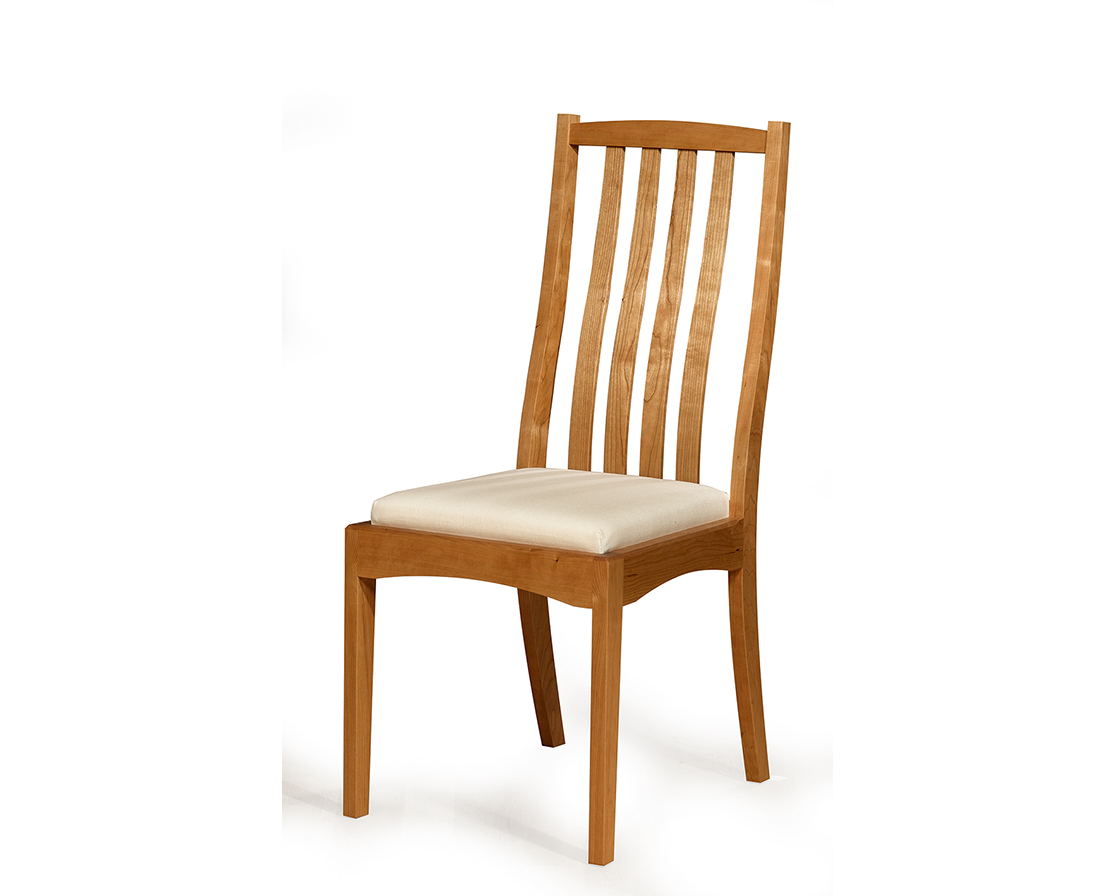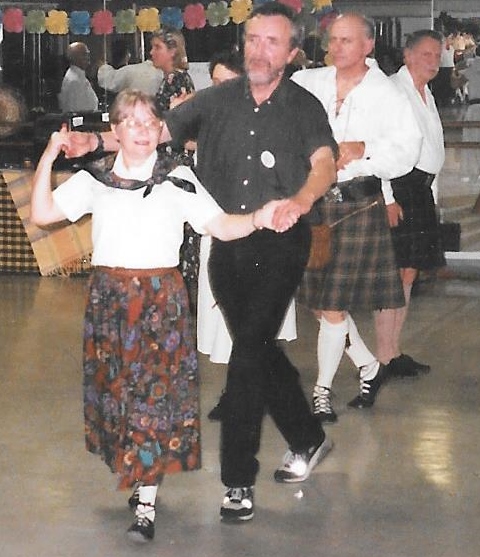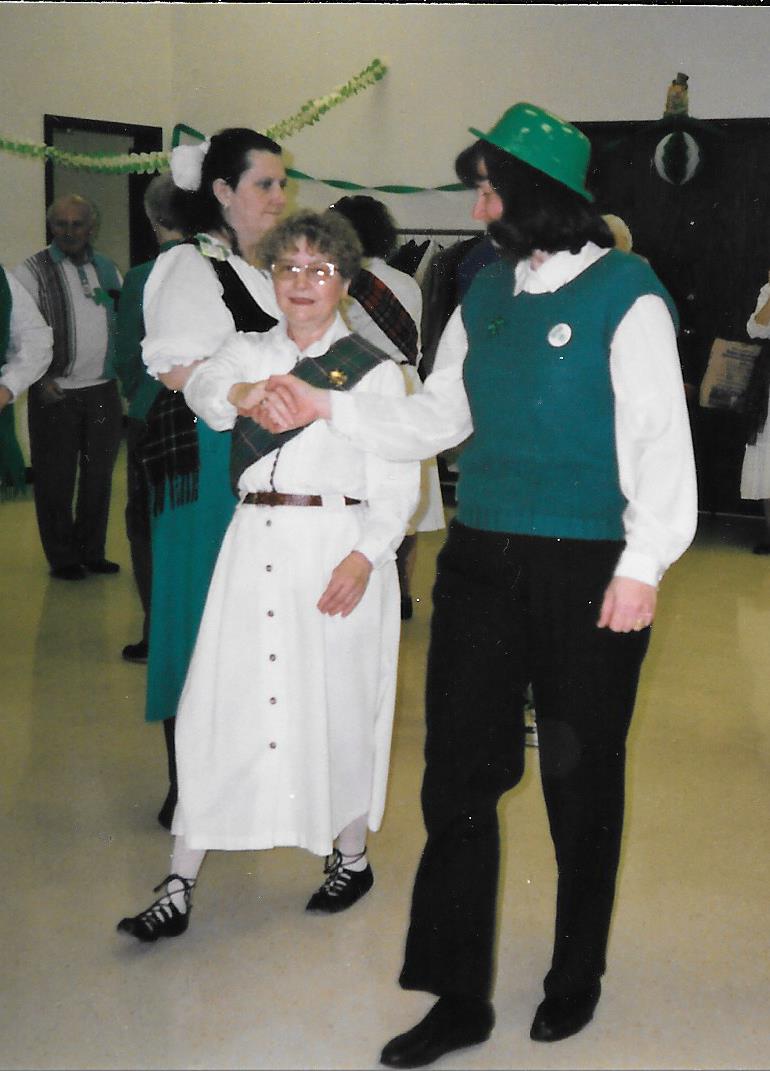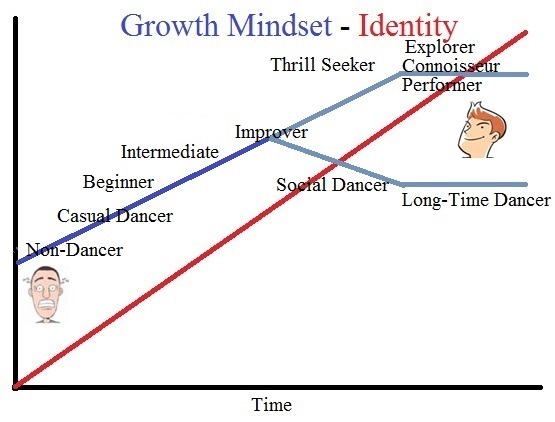
| Volume 34 #3 | November/December 2017 | |
 |
I'm writing this in the afterglow of last night's Fall Dance -- what a special way to spend an evening with dancing friends! The first local dance of the season, the program was very accessible to new as well as well seasoned dancers; and over 30 of us gathered to "Celebrate the Scots" and dance to the music of Lisa Scott, Linda Danielson, and Leslie Hirsch. And it wasn't over when it was over -- we retired to the lobby to share a "tea" and confections (and maybe replace some of the calories burned so melodiously a few minutes earlier).
Of the many things said of Scotland and the Scots last evening, one fact was not noted: Scotland, contrary to its popular image, has one of the highest rates of charitable giving of any country in the world! I just mention that because the Southwest Washington State Branch of the RSCDS is registered with the Internal Revenue Service as a 501(c)(3) non-profit corporation, organized for the purpose of educating the public about the technique, history, and social benenfits of Scottish Country Dancing. Because the government recognizes the social value of this education, as well as the government's own limited ability to support every beneficial cause, the government partially reimburses people who donate to such non-profit corporations. In other words, donations to our branch are tax deductible "to the fullest extent of the law".
You might keep that in mind as we head into this "season of giving" and you find yourself pondering where to bestow some beneficence before this tax year runs out. Last night's affordable dance was just one example of how the funds of the Branch are used. We hold other dances through the year -- all with live music -- as well as classes with fine, dedicated teachers -- also provided to the community at affordable rates. Often, keeping things "affordable" requires the Branch to underwrite the activities at a loss; and at such times, all donations are very much appreciated.
(Note: upon request, the branch Treasurer can supply you with a donation receipt suitable for filing with your tax returns.)
The Groundhog Day Scottish dance will be held Saturday, February 3, 2018 at Columbia Dance Center, 7:30pm, with music by the The Soohoo-Hui family. $10 admission.
For dance cribs and diagrams, visit: http://www.rscds-swws.org/2018-groundhogdaydance-cribs.pdf
For animated instructions, visit: http://www.rscds-swws.org/2018-groundhogdaydance-danciemaetions.htm
We can view the trailer of the Groundhog Day movie, in which TV weatherman Phil Connors relives Groundhog Day over and over and over.
The typical Scottish dance program has twelve dances. The Groundhog Day dance has six dances in the first half, and we repeat the same six dances in the second half. These are six of the best Scottish dances, that would be really fun to dance a second time.
Like the movie, the program is scripted for the second half to duplicate the first half pretty closely. The emcee welcomes everyone to the dance, introduces the musicians and briefers, etc. The second half repeats the same introduction, as if the first half had not happened. In the movie, each new cycle of Groundhog Day plays out slightly differently, as Phil Connors learns from earlier cycles. Dancers can similarly act out their own interpretation. They might repeat dances with the same partner they had the first time. They might dance more confidently the second time with knowledge gained from dancing the first time, which might result in improved "spirit of the dance". Dancers benefit more from having made the effort to learn each dance.
Save the date for the fun Groundhog Day dance. We know how it begins, but we are unsure when the dance will end!
As collected by Eunice MacKenzie
Wha's Like Us - Damn Few And They're A' Deid
The average Englishman, in the home he calls his castle, slips into his national costume, a shabby raincoat, patented by chemist Charles Macintosh from Glasgow, Scotland. En route to his office he strides along the English lane, surfaced by John Macadam of Ayr, Scotland. He drives an English car fitted with tyres invented by John Boyd Dunlop of Dreghorn, Scotland, arrives at the station and boards a train, the forerunner of which was a steam engine, invented by James Watt of Greenock, Scotland.He then pours himself a cup of coffee from a thermos flask, the latter invented by Dewar, a Scotsman from Kincardine-on-Forth.
At the office he receives the mail bearing adhesive stamps invented by James Chalmers of Dundee, Scotland.
During the day he uses the telephone invented by Alexander Graham Bell, born in Edinburgh, Scotland.
At home in the evening his daughter pedals her bicycle invented by Kirkpatrick Macmillan, blacksmith of Dumfries, Scotland.
He watches the news on his television, an invention of John Logie Baird of Helensburgh, Scotland, and hears an item about the U.S. Navy, founded by John Paul Jones of Kirkbean, Scotland.
He has by now been reminded too much of Scotland and in desperation he picks up the Bible only to find that the first man mentioned in the good book is a Scot, King James VI, who authorised its translation.
Nowhere can an Englishman turn to escape the ingenuity of the Scots.
He could take to drink, but the Scots make the best in the world. He could take a rifle and end it all but the breech-loading rifle was invented by Captain Patrick of Pitfours, Scotland.
If he escapes death, he might then find himself on an operating table injected with penicillin, which was discovered by Alexander Fleming of Darvel, Scotland, and given an anaesthetic, which was discovered by Sir James Young Simpson of Bathgate, Scotland.
Out of the anaesthetic, he would find no comfort in learning he was as safe as the Bank of England founded by William Paterson of Dumfries, Scotland.
Perhaps his only remaining hope would be to get a transfusion of guid Scottish blood which would entitle him to ask "Wha’s Like Us".
Dawn Pratt, Jennifer Pratt-Walter’s Mom, passed on September 11, 2017. A memorial service was held October 13, 2017 at the Unitarian Universalist Church, Vancouver.
 |
 |
Dawn joined us in the early 1980s. Through the ensuing years she hosted numerous summer picnics in her garden. She opened her home many a spring/fall/winter for ceilidhs, socials and Christmas parties.
Many of you will remember dancing with Dawn in classes, at dances and demos as well as dancing in her home north of Camas. She last joined us in our Phantom of the Dance, October 2002. I do not recall her dancing very often after that, perhaps in classes for a while.
Some of you will remember our ten plus years dancing at Fort Vancouver. Geri Stuart and I reconnected with people from our collective past: Marvin and Sue Benson (Fort Vancouver);
Alice Pratt Frascone
(joined our SCDance while still in high school); Rev. Frodo Okulam (member of Portland Fiddlers) who officiated at the memorial; Valery Blesley (harpist).
Friends, other Pratt family, and care givers, reminisced with stories of a full life well lived. We extend our sincere sympathy to all surviving family.
I read a paper authored by Ian Brockbank for the 2009 Kaleidoscope SCD Conference, titled Dancers, a spotter's guide that describes qualities of ten types of Scottish dancer. I became interested to relate the dancer types to my previous research titled Growth Mindset and Identity in Recruiting and Retaining Dancers that explores why over 95 percent of the public do no dancing of any kind. A person with a Growth Mindset is motivated to work hard in order to improve their dancing abilities, and is less concerned about feeling stupid or looking stupid. A person's Identity increases as they strengthen friendships and Scottish dance becomes an increasingly important part of their self-image.
 |
I added the Non-Dancer type to the list and arranged the types on a simplified chart that displays the Growth Mindset and Identity dynamics, in order to show the trends and psychological blocks.
Identity is related to a person's interest in Scottish culture or music. We rely on Identity when we invite friends and family. However the Fixed Mindset blocks most people's motivation to try Scottish dance because of their fear of feeling stupid and not wanting others to think they are stupid, and is the main factor that discourages the majority of the public from trying dancing of any kind. Advertising "easy" dances helps to avoid agitating the Fixed Mindset. We can communicate emotionally compelling marketing messages that focus on the beneficial feelings of Scottish dance.
I learned about the "Recovery from Mistakes" skill that Bruce Hamilton teaches, from viewing his presentation and reading his paper from the Kaleidoscope SCD conference, and authored a newsletter item titled
Gold Star! Recovery Is Important, Not the Mistake. The teaching technique sets the expectation:
"Making a lot of mistakes is part of Scottish Country Dancing. It's nothing to get excited about." Bruce sees a lot more open faces. People take a new
figure and dive in, moving boldly with faces outward instead of inward. Dancers learn a useful skill, they know it and feel they are growing and want to come back.
A person's confidence grows as they practice and progress through the stages of Casual Dancer, Beginner, Intermediate, and Improver. The Social Dancer and Long-time Dancer become content with dancing skills they have learned and Growth Mindset declines. The Growth Mindset continues to increase for Thrill-seeker, Explorer, Connoisseur, and Performer.
A person's Identity with Scottish dance and fellow dancers increases over time, and the person joins a community of passionate Scottish dancers who might go so far as to view themselves as a family. Identity helps retain Scottish dancers once they have joined the community. We observe that Branch/RSCDS members tend to renew their membership annually, once they become members. Personal interaction and communication via newsletter, website, and email reinforce Identity.
I am keen to explore methods that engage with the public community in order to connect with those whose Identity stimulates their curiosity to try Scottish dance, and to help them overcome their Fixed Mindset as they grow their dancing skills and begin to add Scottish dance to their Identity.
The next leg was another two-mile trek up what was described as “the straight road”. Patrick got out his chanter and played while we marched along, but it was a road, so we had to keep moving to the side as busses and cars passed us. We overshot our destination, and walked right up to Hadrian’s Wall, which had all of our attention once we got to the main highway. We tried to get off the main road by bushwhacking through a sheep pasture, which didn’t go over well with some of the travelers, who didn’t appreciate the nettles and thistles. We consulted with some hikers coming down off the wall, and upon turning around, we could see our destination Inn that we had just passed up. So we walked back down the hill to the Twice Brewed Inn (it’s in a town called Once Brewed), and had a lovely beverage before checking in, because we were hot and thirsty. It was beautifully modern on the inside and rustically charming on the outside. Patrick and Sally wanted nothing more than to lie on the soft beds in the warm breeze and nap. Holly and I headed back to the Wall, for the “optional” three-mile round trip hike to “Sycamore Gap” (which, it turns out, is a gap in the wall with a sycamore tree growing in it). The Wall “runs with the land”, so there was a lot of rather steep up and down. It was very exciting though, and beautiful, and breezy at the top. We took in some stunning vistas. Upon our return to the Inn, there was the requisite showering, followed by general merry-making in the pub, along with some good-natured accusations about ‘making’ Sally bring too much stuff, which, if anyone has the rare opportunity to try to make Sally do anything, I’m sure they would rush to my defense. There was some good legal talk, too, about representations and warranties. This of course, was accompanied by more lovely beverages and an excellent meal – these people are real foodies! Patrick wiped out early, and Holly, Sally, and I wrapped up the evening with a game of Quiddler. We all turned in by about 9:30pm – Holly with plans to get up super early to catch the sunrise at Sycamore Gap.
Monday, June 19
Holly was up skulking about the house by about 3:30am (as I was up watching bats fly around the patio area, being unable to sleep because of so much congestion that when I lay down, I couldn’t breathe) only to find that we were locked in. We met for breakfast at 8:30am as planned, some of us a little more bleary-eyed than others. I suggested that Sally take the bus to our destination B&B as I was unsure about the terrain for our 6.5 mile walk that morning. She was all for it. So Holly, Patrick, and I set off from the wonderful Twice Brewed Inn, planning to meet Sally at the Roman Museum, just a mile back from our destination at Greenhead at noon. Walking along the wall was amazing – fantastic! The views were incredible, the history palpable, and the terrain was extremely challenging. We were up and down numerous steep hills, following paths that were tenuous at best. We only got lost once, causing about a 15 minute delay, but ended up at the agreed upon meeting place about 2 hours late. Sally, in the meantime, had rested at Twice Brewed, taken the bus to Greenhead, found the Holmhead Guesthouse, where she left her beloved pack, and made her way alone through fields of “unpredictable” mama cows to arrive only 4 minutes late, which gave her time to see everything in the museum at least three times before we got there. It took us very little time to find each other once we had all arrived. The museum had a 3D movie (with glasses and everything) for us to watch about Romans and the Wall. It was quite fascinating except that 1) a class of French students arrived about five minutes after the movie had started, and it took them at least that long to get settled, and 2) with the exhausting walk of the morning coupled with the lack of sleep, the sunburn, and the cool, dark theater, it was very difficult to stay awake. It was really good though. Because of the noise and bluster of all the school kids, our museum experience was less than satisfactory, so we left without trying to absorb all of it. Sally took Patrick and I through a sheep pasture back to the B&B and down into Greenhead to the pub, while Holly went back up the path to find Thirwall Castle, a ruin, which turned out to be just steps from the B&B – go figure. Holly caught up with us at the pub, where our feet were already feeling better due to the cider, applied internally. The only tourists in there, we had made friends with the barkeeper, who was also the chef for later. She had lived all over the world, including Central Texas, and had been, among other things, a horse trainer. We did not find out how she ended up as a barkeep/chef in a tiny town like Greenhead, North Umbria. We had to go back to the B&B to get cleaned up so that we could return to the pub for supper. After supper, Sally, Patrick, and I tried a wee wander on our way back to the B&B, but were too tired to put much into it. Holly went for an explore to try to find a subject for a sunset photo, but once midnight rolled around and the sun hadn’t even tried to set yet, she gave up also.
Tuesday, June 20
We had set our breakfast time for 8:00am, and met in the little dining room at the B&B. We had a lovely breakfast, mothered over by our very talkative host, Judy. There were times when I was sure we would never be able to stop nodding and smiling long enough to take a bite of our eggs. Still, all was excellent, and we did eventually finish breakfast and got underway. We were assured that this day’s walk would be much easier. We had a little over six miles to go over rolling hills. We didn’t actually see a lot of Wall. There were multiple turret formations to look at, but mostly it was wanders through sheep pastures, a couple of cows to be passed, lovely cloudy weather in the morning, and sunny in the afternoon. We found our way to the target B&B, the Quarryside Guesthouse, by about 1:30pm, and were heartily welcomed. We knew we were early though, and so made ourselves scarce by walking down to the local teahouse – a 30 minute walk down a long hill, for a lovely beverage and some lunch. We hung out there for a couple of hours, Holly taking her leave early to hunt photos. The three of us checked out the priory next door to the teahouse, which was really quite something, and then tackled the hill back to the B&B. Chanting, singing, and conversation got us there in no time. Because the Quarryside Guesthouse is actually in Banks, and the teahouse where we had lunch is the nearest place to get food, and is actually in Lanercost, the hosts of our B&B have a deal worked out with a pub in Hallbankgate – The Belted Will. They drove us over to the pub, where they knew we were coming and had a table ready for us. We had a lovely dinner, and the pub owner drove us back to the B&B.
Wednesday, June 21
The Quarryside Guesthouse was a bustling place, with grandchildren being hurried off to school, Peggy the dog checking out everything and everyone, including in the breakfast area where she was not supposed to be. We met some other wall walkers at breakfast and compared notes. They had started in Newcastle and were covering about 10 miles a day, but they were not carrying packs. They had not left themselves enough time to appreciate the museums and pubs along the way either, which I thought was a shame. It had rained through the latter part of the night, and into the morning. We waited until it slowed, but walked the better part of the morning through a light drizzle. We made our way to Brampton, where one of the colorful locals out walking his dog, gave us directions to a footpath that would take us to the train station, which was little more than a platform out in the middle of nowhere. We were able to turn on our hotspot and purchase tickets on our phone in plenty of time before the train showed up. This train took us to Carlisle. From the train station in Carlisle, we walked a short distance to the Cornerways Guesthouse. Unfortunately, this is not where we were staying. We then made our way through quiet neighborhoods to the Cornerhouse Guesthouse, where they were expecting us, and had our rooms already ready. After a brief respite, we ventured forth to find the castle. The Carlisle Castle was quite something, and we spent an hour or more wandering through it, looking at interesting staircases, alcoves, etc. There was a history of how Bonnie Prince Charlie had taken that castle during his attempt at the throne. Holly peeled off to check out a nearby park, while Sally, Patrick, and I went to visit the cathedral. The cathedral and grounds were quite impressively old and extensive. Sally went off to find a Methodist Church that she was interested in, and Patrick and I went to enjoy a pint at a very nice pub, The Griffin. We met back at the guesthouse, got cleaned up, and headed out for dinner. After looking at numerous menus along the main street, we ended up at The Griffin again – our favorite pub in Carlisle! I was invited over to the girls’ room for Quiddler, and returned to find Patrick watching Monty Python and the Search for the Holy Grail on his phone, only to fall asleep well before it was over.
Thursday, June 22
The guesthouse rooms were quite spacious and nicely decorated. Before we left the next morning I asked the proprietor if she had done the decorating herself – she had, and was quite pleased that anyone had noticed and appreciated it. We went back to the train station in Carlisle to get tickets to Alexandria. It turned out that if I had bought the tickets the day before on my phone, which I was prepared to do, but wasn’t sure what time we wanted to get going, so I didn’t push the button, it would have cost us £8, but because we were buying tickets the same day as we were traveling, the best they could do for us was route us through Glasgow and charge us £28 each! Unbelievable. We had to transfer from a “Virgin” train to a “Scotsrail” train in Glasgow, and got a little lost between train stations, but eventually arrived in Alexandria unscathed. The 2.5 mile walk from Alexandria to Balloch along the River Leven was quite pleasant, and we checked in at the Innkeeper’s Lodge, just south of where the River Leven flows out of the Southern end of Loch Lomond. We had a bite to eat at the pub, then Holly went off to find the Castle, while Sally, Patrick, and I went to the Info station across the street and then off to throw a rock in the Loch for good luck. We explored the Maid of the Loch, a steamship tour boat that is being restored to its former glory. We wandered back to the Inn, where we dropped Sally off, and Patrick and I went to find the Castle. We never did find it. The castle is in a large park, filled with hiking trails. We hiked through the woods, and found a walled garden that was quite lovely, and a stump that had been carved into a gnome home, that was quite charming, before walking back to the Inn to clean up for dinner. We had a date that evening with Andrew Smith, a Scottish Country Dance teacher who we have had teach the Portland Workshop, and who lives most of the time in Emporia, KS, and his brother David who lives along Loch Lomond. We had a lively dinner, with lots of catching up, advice for what to see next, dance talk, laughter, and general socializing. We were plenty tuckered out and ready for some sleep by the time we got back to our rooms.
Alisdair Biggar, a Scotsman, applied to join the New York City police force. The hiring inspector glared at him and asked, ‘How would you disperse a large, unruly crowd?’ ‘Well,’ replied Alisdair thoughtfully, ‘I’m no too sure how ye do it here in New York. But in Aberdeen we just pass the hat around, and they soon begin to shuffle off.’
Calendar of Events | ||||||||||||||||||||||||||||||||||||||||||||||||||||||||||||||||||||||||||||||||||||||||||||||
|
|